Yanmar 1610D 1979 Tractor
A Greymarket 1979 Yanamar 16010D Tractor Rebuild Project!
Yanamr 1610D 1979 Tractor
After moving to Sandy, Oregon and getting some acreage what used to be small projects like ‘Move some dirt from here to there’ turned into extreme exercises that made me appreciate better just how good we have it these days. So in keeping with the theme of how good we have it these days, I started looking at tractors and other similar tools that could be helpful for a number of tasks around the property.
Picking a Tractor
Looking for a tractor can be, well a wild experience of trying to find the right tool for all the jobs you think you might have. So I tried to lay out my goals, and see where that took me.
- Small Physical Footprint to fit through forested areas
- 4WD or AWD to handle sloped grassy terrain
- Loader bucket to move dirt and things around
- I am handy, so I didn’t mind working on a tractor, but something with decent part availability, or parts simple enough to repair/fabricate, or a good dealer relationship
- Cheap to operate and buy
- Probably less than 25 HP
- PTO is a perk, but PTO is not needed
- If a newer machine, looking for new(er) so I can keep up on maintenance
- If older, looking for something I can rebuild without expensive dealership costs
- Diesel Engine for no real reason, and most of them are diesel anyways
All of this lead me to look in the ‘Small Compact Utility Tractors’ segment. I did consider a skid steer, but the costs were way higher.
I looked at new tractors, and while a lot of the modern features seemed ’nice to have’ I decided pretty quickly that I’d rather buy an older tractor in good, or workable shape with more track record, and less systems to maintain or repair. In particular, a unit with no complex computer systems to contend with.
1979 Yanmar 1610D Stats
I ended up deciding on a Japanese built Yanmar 1610D built in 1979, this is a ‘Greymarket’ imported tractor brought into the USA illegally as at the time John Deere sold Yanmar manufactured units in the USA and had agreed to not sell Yanmar branded units during that time.
- 21 HP Diesel Engine
- 1.3 Litre 3-Cylinder
- Liquid Cooled
- 16 HP PTO Power 540 RPM
- 4x4 MFWD 4WD
- 9-speed partial power shift Transmission
- Type - partial power shift
- Gears - 9 forward and 3 reverse
- 2200 lbs Wet Weight
Picking Up the Tractor
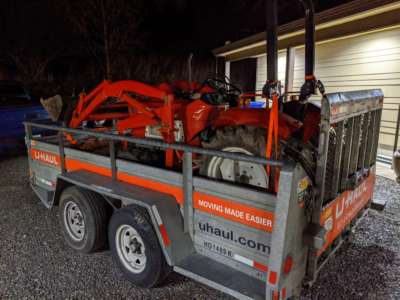
After making arrangements with the seller, I picked up a uHaul trailer, which ended up working great, it just barely fit, but handled it well.
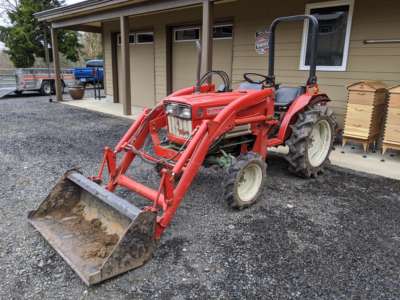
This tractor was not as well maintained as it could have been, greese fittings were painted over, and clearly it needed some TLC, but the hours were low, and it hadn’t been used for more than a season since it was went through. So I decided I found it in time since it started right up, and didn’t have much slop or areas of concern.
Rebuilding the Electronics and Maintenance
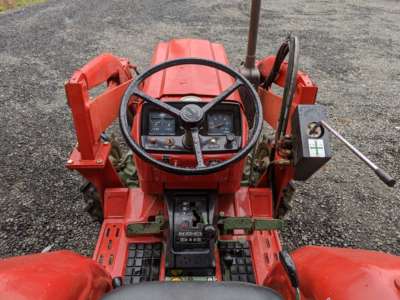
None of the electronics worked on this tractor, and while I think that’d be a scary admission on a newer tractor, this older WWII tech tractor had just a few wires to sort out. I removed the at the time innovative ‘Battery Fluid Sensor’ module, and rewired the entire dash since the lights, buttons, turn signals, and other elements didn’t work. I found mostly the issues to be because of poor grounding due to overpainting, and a bad wire or two that I replaced quickly enough.

I also repaired the temperature sensors, the lights, replaced all the switches on the dash, and wired in a trickle charger bulkhead adaptor so I can charge it without opening the hood. That trickle charge port adaptor also reports battery level with a blinking LED, and none of the stock indicators would tell the battery level, so that was a definite perk. One final touch, since my land is hilly, was to add a tilt gauge just to help keep aware on side to side tilt.
After the electronics were sorted, I replaced fluids, filters, and touched up a few paint areas to bring it back to a known good state.
Wheels, Tires, and Ballast
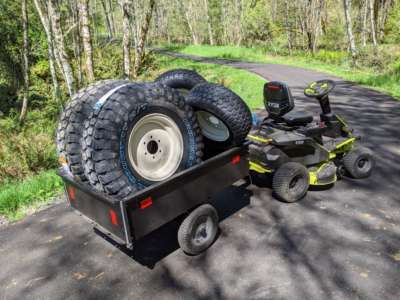
For a few weeks I ran the tractor with the stock tires, but I ultimately decided to swap out the original tires with a set of ’turf tires’ or basically a wider off-road truck tire for better stability, more grip, less ruts, and actually a higher payload rating. I guess I can thank the truck culture for cheap affordable large truck tires for off-road use. The AG tires that came off actually didn’t have the same grip on grass, dirt, or gravel, and these new tires are wider enough to feel the difference when using the loader. The original tires were designed to work well in a rice paddy, or very muddy field, so they also held the tractor higher off the ground than I needed it to. The new turf tires are just a bit lower to the ground, and it helped reduce the feeling it was gonna flip over.
Tire Sizes
- Keep in mind the tires use custom rims from Hoye, so the stock rims won’t hold these tire sizes.
- Fronts: 23x10.5-12
- Rear: LT315/7R16127/124Q
Here are some comparisons of the tire profiles for the front, and back. The new tires are on the left, the originals are on the right.
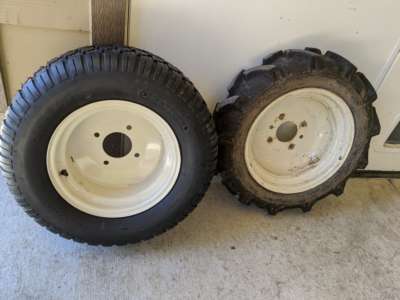
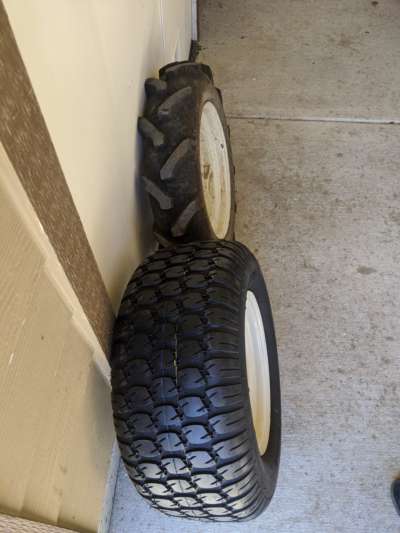


After tires got swapped, I then attached a ballast box to help keep all the wheels touching the ground. Don’t ask me if I know how to ’tricycle’ a tractor!
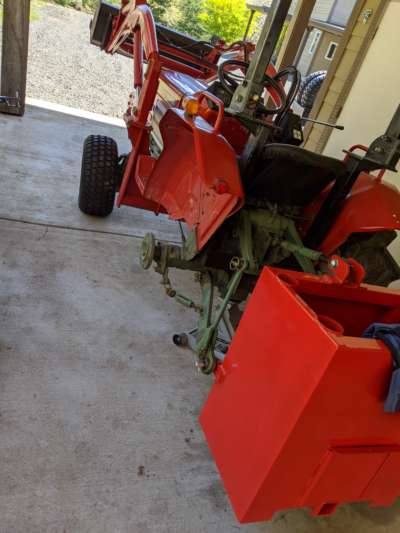
Resources
Check out hoyetractor.com - Their store has a fairly comprehensive set of parts.
Maintenance Log
- 2/20/2022 - Exhaust Flapper
- 6/1/2021 - Loaded Wheels
- Filled wheels with liquid weight, mixed slight antifreeze mix in with water.
- 5/1/2020 - All Fluids Replaced
- Hydraulic Oil
- Shell Rotella HD Tractor Transmission & Hydraulic Fluid, 5 gal. Pail
- Engine Oil
- Shell Rotella® T6 5W-40 full synthetic
- Differential Oil
- Lucas LUC10043 Oil SAE 80W-90 Heavy Duty Gear Oil
- Hydraulic Oil
- 5/1/2020 - Change Oil, Fuel, and Air Filters